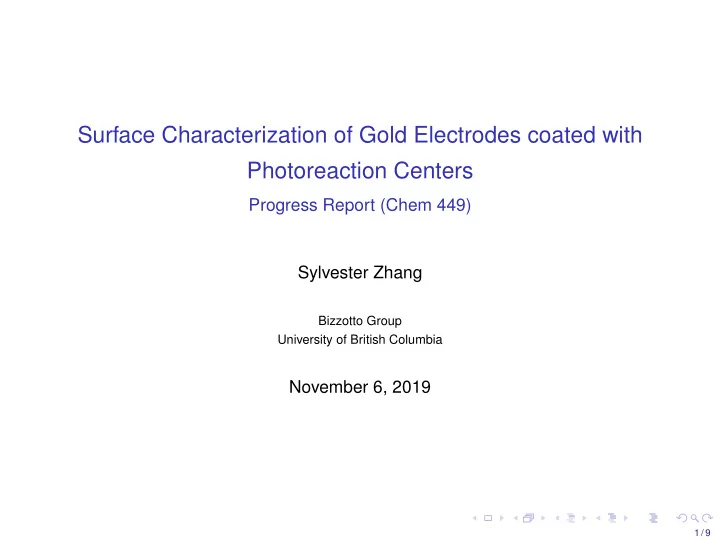

Surface Characterization of Gold Electrodes coated with Photoreaction Centers Progress Report (Chem 449) Sylvester Zhang Bizzotto Group University of British Columbia November 6, 2019 1 / 9
Motivations Binding and measurement of Langmuir isotherm to determine coverage protein on electrode characteristics of protein on Gold Evidence of electron tunneling via maximum photocurrent vs electrode separation 2 / 9
Introduction Photoreaction Redox active cofactors - When P (yellow molecule) center chlorophyll-like molecules that absorbs light, and extracted from absorb light and excite an electron electron excited, electrons bacterium flow down this pathway membrane 1. Rhodobacter sphaeroides photosynthetic bacteria. 2. Relevant protein: ”Reaction Center” or ”RC” 1 1 Jones, M. R. The Petite Purple Photosynthetic Powerpack. Biochm. Soc. Trans . 2009 , 37 (2), 400–407. 3 / 9
Methods Cyclic Voltametry Periodic Lock-in Method excitation of reaction center 1. Measure electrochemical current - background signal (mA) from electrode - redox species in solution 2. Light excites photoreaction center periodically - generate small desired signal (nA/pA) from reaction center to electrode transfer 3. Measure periodic increase and decrease in current - consider this photocurrent 2 2 Jun, D.; Beatty, J. T.; Bizzotto, D. Highly Sensitive Method to Isolate Photocurrent Signals from Large Background Redox Currents on Protein-Modified Electrodes. ChemElectroChem 2019 , 6 (11), 2870–2875. 4 / 9
Photocurrent Signal Origins Excited electron donates to Photoreaction center electrode flexes when excited, resulting in a 13 Hz change in background signal 1. Source of detected currents may be from: 1.1 Electron transfer from protein to electrode 1.2 onformational flexing of reaction center changing effective concentration of mediators near electrode 5 / 9
Identifying sources of signal No light - control results in no photocurrent signal, and no locked in phase signal. Operation with light shows real signals occuring at 13 hz. 6 / 9
Adsorption Characterization Increasing coverage = increasing photocurrent, decreasing capacitance Maximum photocurrent vs protein Capacitance (F) vs concentration concentration (signal variations) 7 / 9
Future Directions Reaction center molecules 1. Ensure that photocurrent observed is truly from excited protein 2. Explore possibility that electron transfer from protein is electron tunneling 8 / 9
Acknowledgments Prof. Daniel Bizzotto Dept. Microbiology and Immunology Ms. Tianxiao Ma Prof. Thomas Beatty Mr. Adrian Grzebowsky Dr. Daniel Jun Ms. Jessica Shi Ms. Amita Mahej 9 / 9
Recommend
More recommend